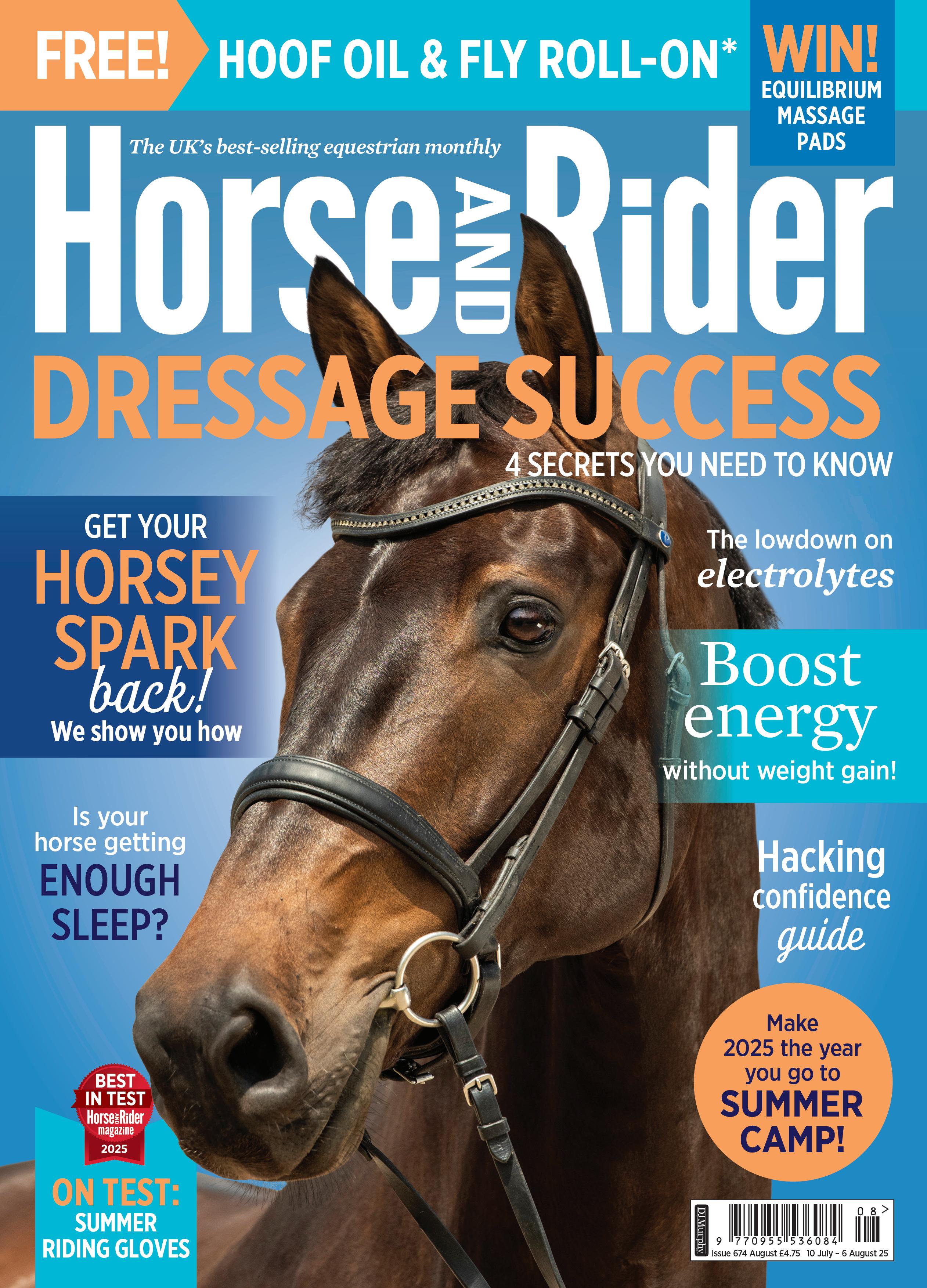

August 2025 issue
EDITORIAL
Editor-in-Chief Louise Kittle
Assistant Editor Sarah Burgess
Sub Editor Halima Crabtree
Staff Writer Nicky Moffatt
Editorial Assistants Kirsty Lucas, Megan Xavier-Witherington
DESIGN
Head of Art and Design Sarah Garland
Deputy Head of Art and Design
Adam Witt
Designer Lucy Claydon
ADVERTISING & MARKETING
Commercial Director Abi Cannon
Advertisement Manager Evie Edgar
Production Manager Eleanor Dunn
Marketing Co-ordinator Alison Hill
Digital Marketing Manager Lianne Tadd
Marketing Assistants Alex Uren, Emily Weeks
Art Editor Paul Smail
For advertising queries, please call Main office 01428 601020 Abi Cannon 01428 601028 Evie Edgar 01428 601031
OPERATIONS
Managing Director Zoe Cannon
Accounts Manager Caroline Leishman
Accounts Executive Sarah Smith Office Manager Vicki Owen
DJ Murphy is an Associate Member of the British Equestrian Trade Association
All product prices are RRP. Prices correct at the time of going to press.
SUBSCRIPTIONS 01442 820580 horseandrider@webscribe.co.uk horseandrideruk.com Back issues horseandrideruk.com/shop
We are committed to equine welfare as the core principle of our brand. We work hard to create content that supports readers to better care for, understand and ride their horses, helping to inform and educate with the goal of benefitting equine wellbeing and supporting the strengthening of the equine-human bond. We uphold these aims in everything we do.
NEVER MISS AN ISSUE
Order a single issue bit.ly/HR_BUYACOPY
Subscribe to Horse&Rider horseandridersubs.com 01442 820580
Download a digital issue via your app provider Back issues horseandrideruk.com/shop
OUR AWARDS
PPA Independent Publisher awards
Commercial Partnership of the Year 2023 – shortlisted Team of the Year 2023 – winner
TRAINING
22 COVER Love hacking Build your confidence with our new series
26 On the right lines Fine-tune your cross-country skills
30 Staying straight Ros Canter shares her gridwork tips to improve agility
36 COVER Levelling up Learn to ride entry-level dressage tests
40 Try something new... Side saddle
52 10 minute exercise Conquer downhill transitions with confidence
62 Be disciplined Tailor your workout to boost your own performance
CONFIDENCE
44 COVER Rekindling the joy How to get your riding mojo back
54 Stop the chatter Use mindfulness to help banish negative thoughts
EXPERT ANSWERS
75 Your burning questions: answered
HORSE CARE
58 No stress The common causes of stress in horses
68 Ready for anything How to deal with a vet emergency calmly
88 COVER Energy boost Feed for energy but without the weight gain
94 COVER Sleep tight... Is your horse getting enough rest?
98 A clean sweep Keep pests under control on your yard
118 COVER All about electrolytes Find out more about these essential nutrients
SHOPPING
10 Out & about Must-have products for when you’re on the go
106 COVER Tried and tested Lightweight riding gloves
122 COVER Buyer’s guide Electrolyte supplements
114 Buyer’s guide Trailers
112 This month we love... Riding boots, pressure washers and much more!
127 Dream horsey homes Find your ideal equestrian property

GOOD READS
together BHS aims to raise driver
things to know about The European
hub What you’ve been up to
up to date Discover the latest news in the equine industry
COVER Summer camps Everything you need to know
Giveaways Amazing goodies for you and your horse
102 Back to school Fancy a change in career? Discover the options on offer
Safe and secure Simple security
My life with horses A week in the life of author Jacqui Rose
COVER Reader offer Claim your free hoof oil and fly roll-on
DJMur phy





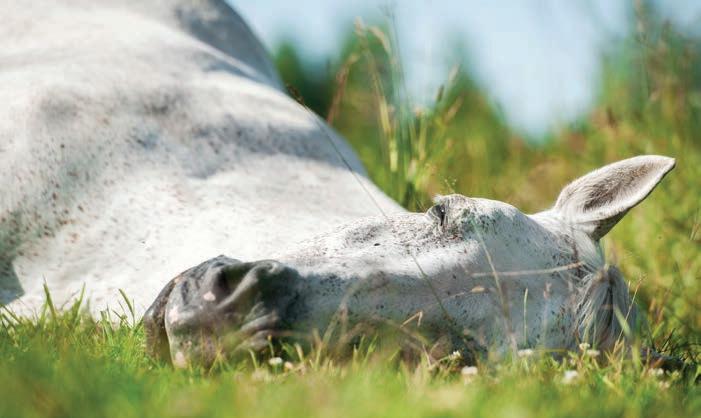


On the right lines
PART THREE: CROSS-COUNTRY
Use Alicia Wilkinson’s exercises to confidently tackle cross-country combinations
EXPERT
Alicia Wilkinson is an event rider, BE UKCC Level 3 and BHS coach based in Essex. She’s competed up to 4* and runs a small team of horses from her yard at home.

Much like showjumping, keeping to the correct line and preventing unnecessary drifting or hesitation on the cross-country course can be the difference between a perfect take-off and a run-out. But with all the additional twists and turns you might encounter, your horse also needs to be well-balanced, whatever the terrain, to jump precisely and efficiently.
I’ve highlighted two types of line that will come in handy, along with some tips on how to practise them, and what to think about as you progress.
TOP TIP
Building XC fences at home using poles and wings can come in handy when you want to practise lines with the safety net of being able to adjust the height to suit your horse.
Remember...
The quality and adjustability of your canter is essential for successful cross-country riding. Keep your horse in a forward rhythm without letting him rush.
Curving lines
TOP TIP
When training, set your horse up for success by choosing your fences wisely and gradually introducing him to new ideas.
Riding a curved line between fences requires a combination of planning, balance and technique. They can be challenging because you need to maintain control and rhythm while preparing for the next fence or obstacle on a turn, and all at greater speed than in the showjumping arena.
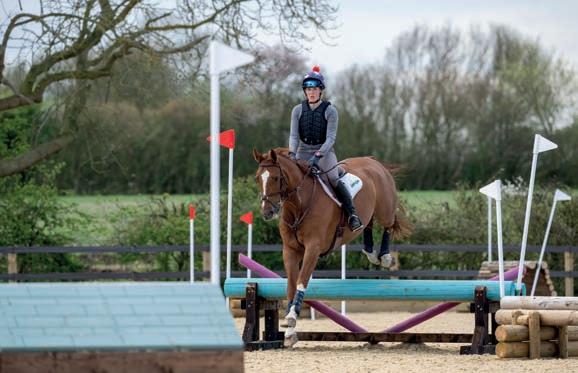
In this feature
Develop XC confidence
Learn to jump on an angle
Tackle tricky combinations


Alicia’s actions
When schooling, choose two fences that can be ridden with a curving line between them – start with a gentle curve and increase the combination difficultly as your skills progress.
To ride this type of line, think about...
• assessing it first – plan the overall direction you need to go in, the steepness of the curve that will ensure you reach the second fence straight and how many strides you need to aim for between the fences
• approaching the first fence head-on
and channelling your horse straight but looking up towards your next fence
• as your horse jumps the first fence, putting a little more weight into the stirrup that corresponds with the canter lead you want him to land on – avoiding leaning with your upper body, though
• guiding and supporting your horse around the curve by using your outside rein close to his wither and inside leg to encourage a little bend through his body
Levelling up
Part one: Introductory
Learn to ride entry-level dressage tests accurately and correctly for maximum marks


Maybe you’re new to dressage or you have an inexperienced horse. Either way, Introductory level is the starting point if you’re intending to compete.
As the name suggests, it’s the first level of difficulty in the British Dressage test series, and requires only walk and trot to be shown. Nevertheless, the premise remains the same as in more complex tests in that horses and riders are asked to perform a series of predetermined movements and transitions that are judged on precision, elegance and harmony. As a result, regardless of the level you’re riding at, mastering the fundamental dressage elements and skills will stand you in good stead going forward, so let’s look at some of these and how to improve them.
You need...
TOP TIP
While these movements might appear basic, they can be difficult to do well. When you succeed you’ll gain valuable marks, so it’s worth the effort.
Centre lines
When you ride this, the judge is looking for...
• balance in the turns
• accuracy and straightness of the line
• regularity of the pace
• consistency in the contact
Exercise
Ride a centre line between tramlines of poles.
Photos: Jon Stroud
Tania Grantham is a rider, trainer and polework specialist, as well as a writer and the host of podcast Poles, Piaffe and Prosecco. She is also the author of Inspire Dressage Polework Journal EXPERT
Six poles Four cones
Mastering the fundamental dressage elements and skills will stand you in good stead regardless of the level you’re riding at
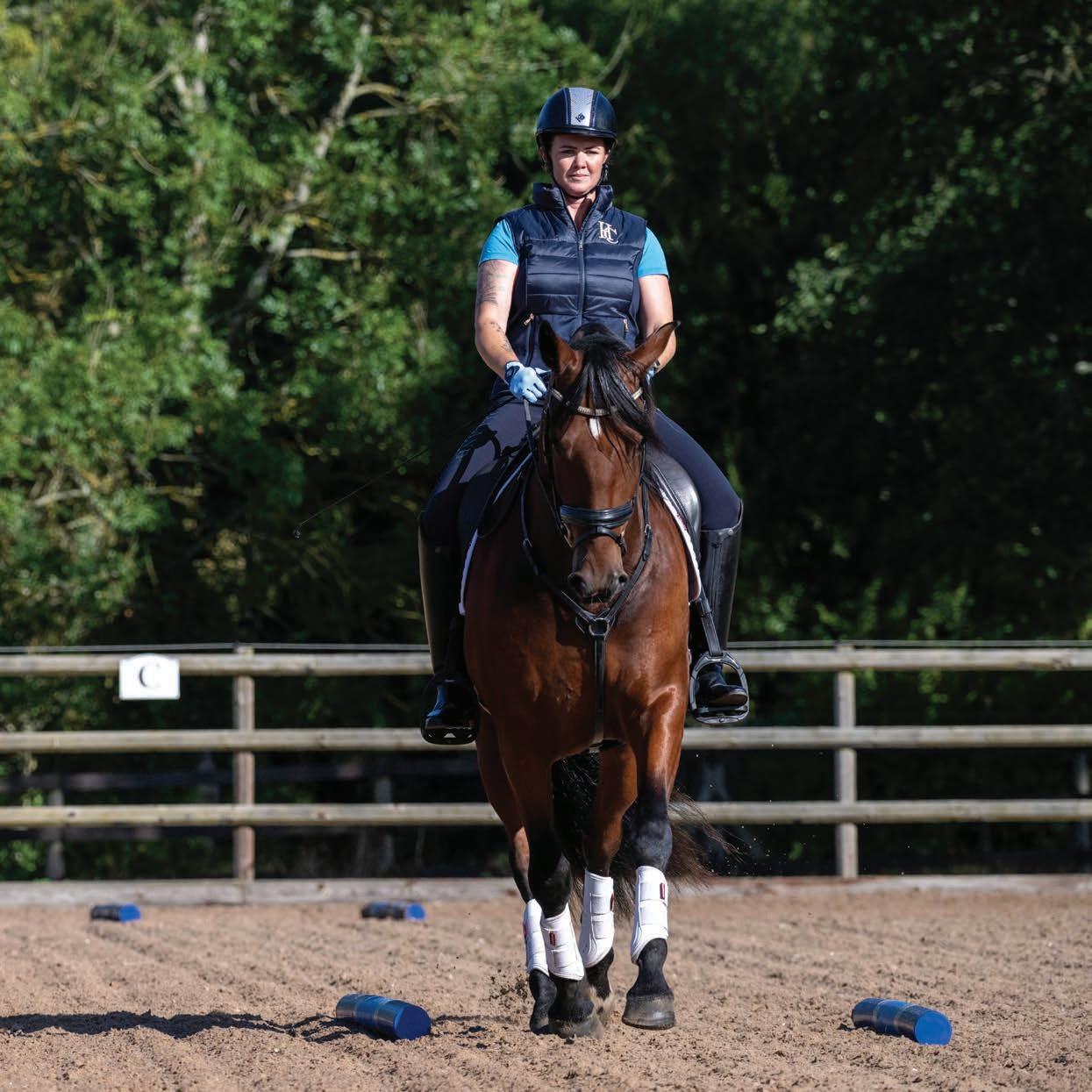
Why it works
The poles act as a guide for the turns and line. They create a visual barrier to stop your horse from drifting or swinging, while helping you focus and plan ahead. How to ride it
The turn starts from the long side. Ride a half 10 metre circle, touching the short side at the quarter line, then look down the centre line between the tramline of poles. Once you’re on the centre line, keep looking up and ahead of you.
Your shoulders, hands, hips and heels should remain level, and your elbows should be by your side with your hands evenly on either side of the neck. Keep your legs closed around your horse. To help maintain straightness, think of pointing your knees towards the end of the line. Practise turning in from both reins, and note any differences that you feel in your horse, which you can then work on.
In this feature
Tackle centre lines Ride accurate 20m circles
Perfect your free walk on a long rein
TOP TIP
At the start of a dressage test, you can choose which rein you enter from, so pick the one that will make the best impression for the judge.
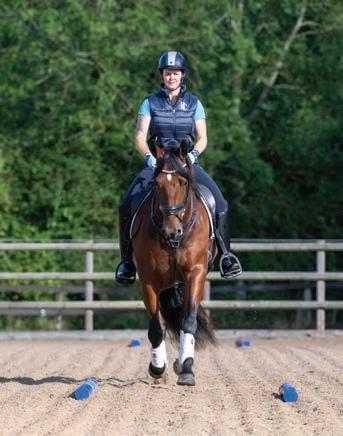
Stop the chatter
Use mindfulness techniques to banish negative thoughts so you learn to love the here and now
EXPERT

Wanting to do the best for your horse is something we all have in common. But in a world where information is so readily accessible at the swipe of a touch-screen button, how can you take what’s useful to you without feeling overwhelmed by the articles, forum posts and social media accounts? All this online ‘noise’, combined with the business of your day to day life and the pressures and strains it brings can open the door to negative automatic thoughts (NATS). And when NATS creep in, we begin to doubt ourselves and our actions. Once we have these thoughts, it’s so easy to continue feeding them with
Make the change
What can you do about NATS? Make sure you’re feeding yourself positive thoughts and remain in your own life, as opposed to living virtually through the internet and constantly comparing yourself with others. Start by... limiting the time you spend online following fewer people restricting the number of platforms you view
more negativity, leaving us feeling anxious, helpless and lacking in confidence. The good news is, there’s plenty we can do to escape this vicious circle.
Reality check
When you first see something interesting online you might feel a spike in the happy hormones endorphins and dopamine, but often this is followed by a slump of self-doubt that releases all the hormones we don’t want. When we experience this high spike and sudden plummet on repeat, it feels awful. Comparison really is the killer of dreams.
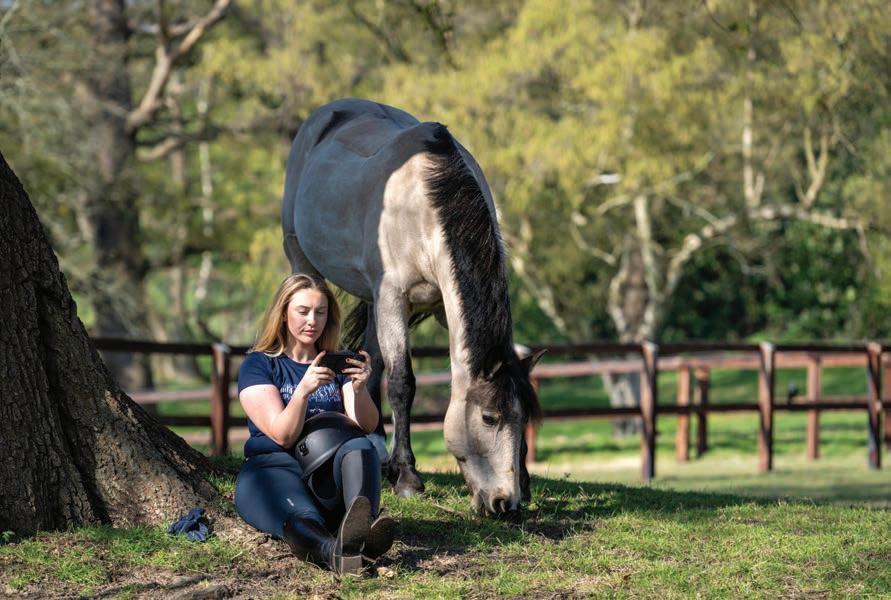
It’s important to remember that we’re all different, as are our horses, and it’s easy to lose sight of that when constantly looking at someone in a fitter body, wearing the latest riding attire or keeping their horse immaculately clean – and so the list goes on. But the reality is, riding a horse with some mud splatters while you’re wearing dirty boots and clothing that doesn’t co-ordinate is far better than not riding at all.
TOP TIP
Remember, posts on social media are snapshots in time and often heavily edited or filtered. They’re not reflective of anyone’s day-to-day life.
Angie Jones-Moore is a certified mindfulness practitioner and runs Moore Unique Life Coaching.

Acknowledge and accept that it’s OK to have negative emotions and there’s no such thing as perfection
Be disciplined
Part one: dressage
Tailor your exercise to boost your performance, no matter which discipline you enjoy


As a rider, you’ll know that you use every part of your body while in the saddle –to stay balanced, give clear commands to your horse and help him remain balanced, too. But how can you make sure you’re at the top of your game to get the most from your horse? I’ve got all the answers you need.
Always active
When riding, you use your lower body and posterior chain (the muscles in your legs and back) to sit upright and maintain your position. Your hips (specifically the gluteal and adductor muscles) hold you in the saddle and your abdominals and trunk help with stability.
As riding is mostly over long, steady distances and of low intensity, the demands placed on
a rider’s muscles and soft tissues are that of endurance. However, riders also need some degree of cardiovascular conditioning, and the necessary extent of your fitness is dependent on the discipline and level to which you train. The combination of the above is known as the physiological demands and the intensity of these demands are also relative to the gait and speed your horse travels at.
Henry Carter MSc is a strength and conditioning coach specialising in rider performance, and owner of Optimal Equestrian Performance.
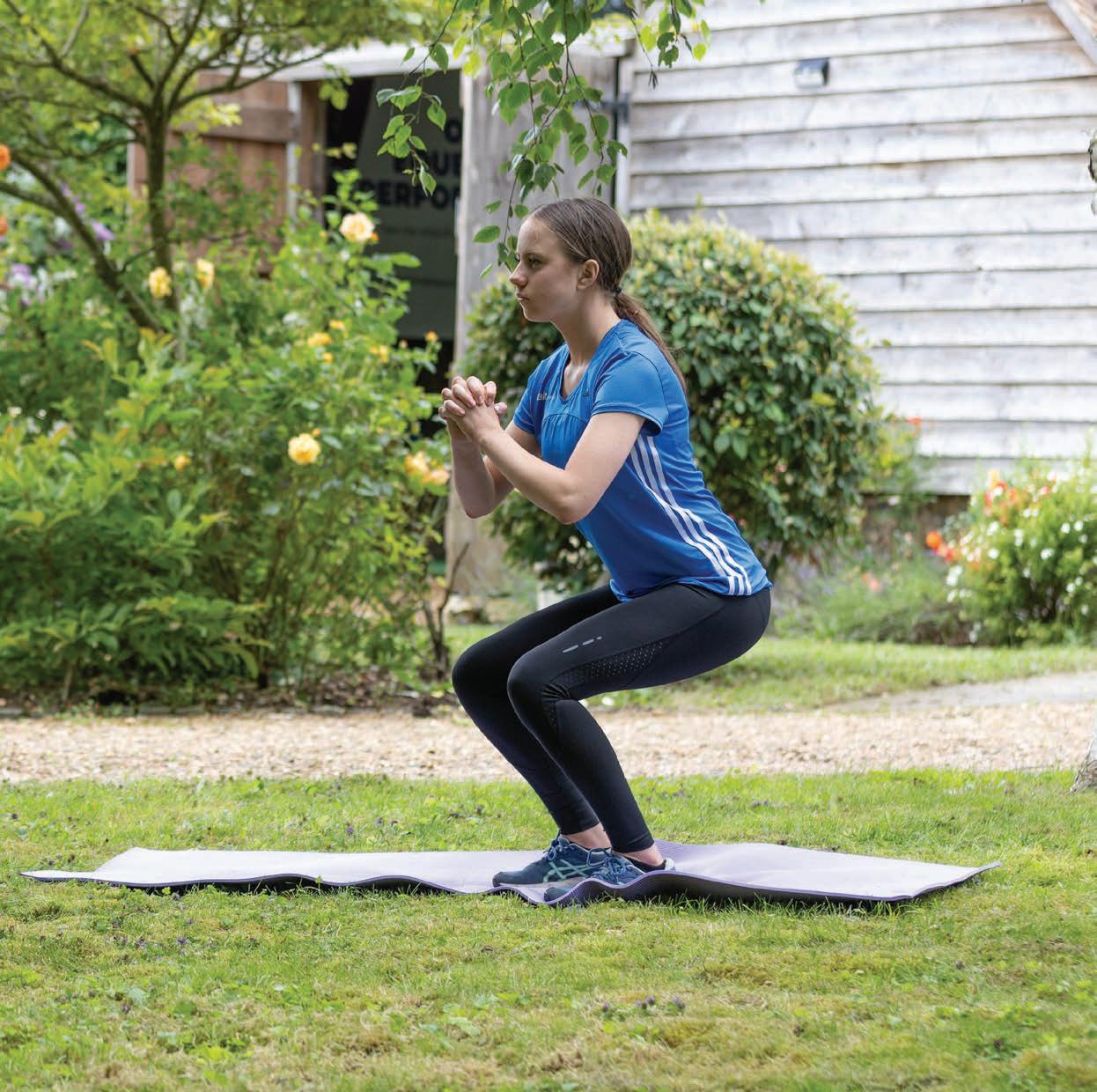
The demands of dressage
When it comes to dressage, the emphasis is on maintaining posture while displaying symmetrical and effortless-looking movements and transitions.
For the rider, the physiological demands of dressage are the same as I’ve just mentioned but with the addition of submaximal isometric strength (the ability to exert a force against a resistance less than the maximum forced that can be produced) and strength endurance of the posterior chain and trunk.
Create your workout
It’s essential to have thorough knowledge of the discipline-specific physiological demands to work backwards from to formulate an accurate training programme. A good training programme also considers the rider as an individual and takes into account factors such as current fitness levels, previous injuries, asymmetries and fitness goals.
Despite this, whichever level you’re training at, your workouts should always be broken down into three key areas, namely...
1. Warm up – reduce the risk of injury and prepare your body.
2. Main focus – work on the key areas to improve your strength and endurance.
3. Stretch out – for recovery and mobility.
Scan the QR code for a warm-up and cool-down guide, and read on to discover my favourite routine tailored to dressage riders.

Photos: Jon Stroud. With thanks to Rossdales Veterinary Surgeons for their help with this feature, rossdales.com

EXPERT
Ready for
Deal with a vet emergency calmly, efficiently and safely with our vet’s advice

Grace Twitchett BVetMed MRCVS is an assistant vet at Rossdales Hertfordshire. She enjoys all aspects of general practice with a keen interest in emergency cases.
It’s an unfortunate fact that horses have a tendency to be accident prone, which means emergencies can happen at any time. By being well prepared, knowing what to do and who to contact, you’ll not only save vital time, you’ll also have confidence in yourself and your ability to cope. This, in turn, will help you stay calm, allowing you to deal with the situation quickly and efficiently.
TOP TIP
To stay safe when taking a rectal temperature, someone should hold your horse while you stand to the side close to his hip in case he kicks.
TOP TIP

Ensure your horse’s tetanus vaccination is up to date, as the bacteria that cause this deadly infection are present in soil and can contaminate the smallest of wounds.
Kit check
At the top of your emergency essentials list should be an equine first aid kit, but you can’t simply buy it and forget about it. Instead, it’s important to check it on a regular basis to ensure dressings are clean and dry (a soiled packet is no longer sterile) and items are in date.
Chlorhexidine solution (often sold under the brand name Hibiscrub) and cohesive bandages are often kit staples, but use chlorhexidine with care, as it’s toxic to cells and, if used incorrectly, can delay healing – instead, flushing wounds with saline can often be a better option.
If chlorhexidine is required (for very contaminated wounds, or on veterinary advice), always follow the instructions for dilution and rinse with saline afterwards. Then, when bandaging, ensure cohesive bandage is used over soft layers such as gamgee or cotton wool, as it can cause damage to skin if applied directly.
Is it normal?
Know what’s normal for your horse – some are more stoical in nature while, for others, being quiet is the first sign something’s wrong. Normal heart rate for a horse is 28–40 beats per minute, but this may rise with stress, excitement or pain. To check, feel the facial artery pulse below the muscular part of the lower jaw. Normal respiratory rate is 8–16 breaths per minute and normal temperature is 37.5–38.5°C.
If you have any concerns about abnormal readings, or note changes in your horse’s health, always seek veterinary advice.
QUICK FIX

